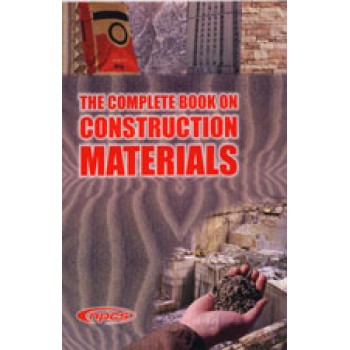The Complete Book on Construction Materials
| Price: | Rs.1,475.00 |
Detail Of The Complete Book on Construction Materials
| ISBN | 9788190439831 |
| Pages | 972 |
| Language: | English |
| Product Code: | 1 |
| Size(in cm): | 21*13.5 cm |
| Weight(in grams): | 500(approx) |
Description:
Construction industry is the largest consumer of material resources, of both the natural ones (like stone, sand, clay, lime) and the processed and synthetic ones. Each material which is used in the construction, in one form or the other is known as construction material (engineering material). No material, existing in the universe is useless; every material has its own field of application. Stone, bricks, timber, steel, lime, cement, metals etc. are some commonly used materials by civil engineers. Selection of building material, to be used in a particular construction, is done on the basis of strength, durability, appearance and permeability. The stone which is used in the construction works, in one form or another is always obtained from the rocks. The rocks may be classified in four ways; geological classification, physical classification, chemical classification and classification based on hardness of the stone. Various king of rocks come under these classification for example; igneous rocks, plutonic rocks, sedimentary rocks, silicious rocks, stratified rocks etc. brick is the most commonly used building material which is light, easily available, uniform in shape and size and relatively cheaper except in hilly areas. Bricks are easily moulded from plastic clays, also known as brick clays or brick earth. Bricks can be moulded by any of the three methods; soft mud process, stiff mud process and semi dry process. There are various kinds of bricks; specially shaped bricks, burnt clay bricks, heavy duty bricks, sand lime bricks, sewer bricks, refractory bricks, acid resistant bricks etc. lime is an important building material, it has been used since ancient times. Lime is used as a binding material in mortar and concretes, for plastering, for manufacturing glass, for preparing lime sand bricks, soil stabilization etc. Concrete is a construction material obtained by mixing a binder (such as cement, lime, mud etc.), aggregate (sand and gravel or shingle or crushed aggregate), and water in certain proportions. Based on the binding materials, the common concretes can be classified as; mud concrete, lime concrete, cement concrete and polymer concrete. World demand for cement and concrete additives is projected to increase 8.3 percent annually in next few years.
This book basically deals with rock and stone, formation of rocks, classification of rocks, geological classification, metamorphism physical classification of rocks, chemical classification,
classification based upon hardness of the stone composition of stone (rock forming minerals), igneous rock forming minerals, sedimentary rock forming minerals, texture of the rocks, types of fractures of rock, uses of stone, natural bed of stone, aluminium and magnesium alloys, mechanical properties of a partially cured resin, DMA characterization, chemical advancement of a partially cured resin, differential scanning calorimeter characterization, chemical mechanical relations, moisture content as a variable, wetability and water repellency of wood, fungal and termite resistance of wood etc.
The book provide wide coverage of building materials such as stone, bricks, lime, mortars, concrete, asbestos, gray iron, cast iron, steel castings, aluminium, wood, architectural paints and so many others with their applications in building construction. The book is resourceful for all professionals related to construction field, technocrats, students and libraries.
Reviews (0)
Write a review
Your Name:Your Review:
Note: HTML is not translated!
Rating: Bad Good
Enter the code in the box below:



 |
| 